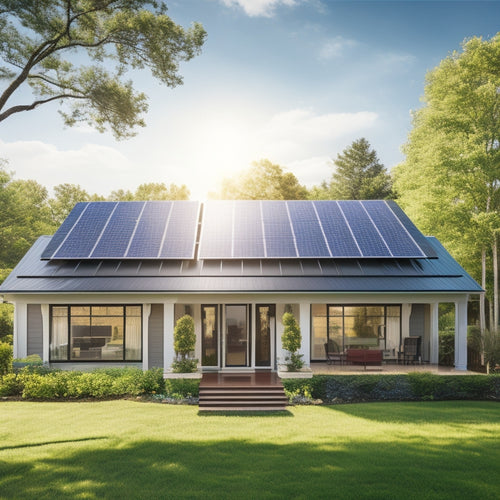
What's in a Home Inverter System
Share
You're about to leverage the full potential of renewable energy with a home inverter system, which is fundamentally a sophisticated ensemble of components working in harmony to convert DC power from solar panels or batteries into usable AC power for your home. This system comprises key components like an inverter, maximum power point tracker, grid tie, and monitoring system, each playing a vital role in maximizing efficiency and minimizing energy losses. As you investigate the complexities of power conversion, grid connection, energy storage, and system design, you'll reveal the subtleties that set a truly optimized system apart, and uncover the secrets to releasing its full potential.
Key Takeaways
- A home inverter system consists of an inverter, MPPT, grid tie, and monitoring system to convert DC power to AC power for homes.
- Inverters come in string, microinverter, and power optimizer types, each with distinct advantages and compatibility requirements with solar panels.
- Key components work together to maximize efficiency, minimize energy losses, and enhance return on investment in a well-designed system.
- The system's efficiency rating and compatibility with solar panels are critical for optimal energy harvesting and reduced energy bills.
- A monitoring system tracks performance through key metrics like voltage, current, and temperature to ensure system reliability and longevity.
Inverter System Components Explained
A home inverter system comprises several critical components that work in tandem to convert DC power from your solar panels or battery bank into usable AC power for your home.
You'll find different inverter types, including string inverters, microinverters, and power optimizers, each with its strengths and weaknesses.
When selecting an inverter, it's vital to take into account factors such as inverter efficiency ratings and compatibility with your solar panel system to guarantee peak energy harvesting.
The inverter itself is the brain of the system, responsible for converting DC power into AC.
Other crucial components include a maximum power point tracker (MPPT) that enhances energy harvesting, a grid tie that synchronizes with the grid, and a monitoring system that tracks performance.
A well-designed system guarantees high system efficiency, minimizing energy losses and maximizing your return on investment.
Power Conversion and Monitoring
You've selected an inverter that meets your specific needs, now it's time to investigate the power conversion and monitoring processes that guarantee your home inverter system operates at peak efficiency.
The power conversion process involves converting DC power from your solar panels or battery storage to AC power for your home. This process is essential, as it directly affects your system's power efficiency. A high-efficiency inverter can minimize energy losses, reducing your energy bills and carbon footprint.
Efficient energy conversion systems play an important role in maximizing energy harvesting and minimizing transmission losses. Advanced power optimization algorithms detect and adapt to changes in energy demand.
Monitoring your system's performance is equally important, as it helps you identify potential issues that could reduce your inverter's lifespan. By tracking key metrics like voltage, current, and temperature, you can verify your system runs smoothly and efficiently, maximizing your return on investment.
Grid Connection and Synchronization
As your home inverter system interfaces with the grid, synchronization becomes vital to guarantee seamless power flow. This involves synchronizing the inverter's output frequency, voltage, and phase with the grid's parameters to prevent any disruptions.
You'll need to confirm your inverter system can detect and adapt to grid disturbances, maintaining grid stability. Inverter compatibility with battery chemistry, voltage, and charging requirements plays a significant role in preventing damage and system failure, and it's important to consult manufacturer documentation for proper integration.
Synchronization challenges arise when the inverter's output doesn't match the grid's conditions, potentially causing power quality issues or even tripping the system. To overcome these challenges, advanced synchronization algorithms and precise monitoring of grid conditions are vital.
Energy Storage and Backup
While your home inverter system efficiently feeds excess energy back into the grid, it's equally important to reflect on how you'll store and employ that energy when the grid is unavailable or during power outages. This is where energy storage and backup come into play. You'll need to evaluate factors like battery technology, load management, and energy efficiency to guarantee a seamless shift between grid and backup power.
| Consideration | Description | Impact |
|---|---|---|
| Battery Technology | Choose from lead-acid, lithium-ion, or other types | Affects cost, lifespan, and performance |
| Load Management | Prioritize essential appliances during outages | Affirms critical systems remain online |
| Installation Guidelines | Follow manufacturer instructions for safe installation | Prevents damage, guarantees peak performance |
| Maintenance Practices | Regularly inspect and maintain batteries | Extends lifespan, enhances performance |
System Design and Configuration
Designing your home inverter system's configuration is vital to guaranteeing it meets your specific energy needs and maximizes performance.
You'll want to evaluate factors that impact system efficiency, such as the type and number of inverters, battery capacity, and charging/discharging rates. Proper load management is also essential, as it guarantees that your system can handle peak energy demands without compromising performance.
A well-designed system should take into account the high-efficiency inverters and charge controllers to minimize energy losses. Additionally, regular monitoring of energy consumption aids in improving efficiency and guaranteeing reliable power without frequent battery depletion or resource wastage.
When designing your system, evaluate the following key factors:
- Inverter size and type: Verify it's compatible with your energy storage system and can handle your maximum power requirements.
- Battery configuration: Determine the best number and type of batteries for your energy needs and budget.
- Charge controller settings: Set the charging/discharging rates to maximize system efficiency and extend battery life.
- Load prioritization: Identify critical loads that require uninterrupted power and prioritize them accordingly.
- System monitoring and control: Implement a monitoring system to track performance, detect issues, and make adjustments as needed.
Frequently Asked Questions
Can I Install a Home Inverter System Myself?
As you commence this DIY adventure, remember, installing a home inverter system yourself is like steering through a stormy sea - you must chart a course through complex installation requirements and safety precautions to avoid shipwreck.
How Long Does a Typical Inverter System Last?
You can expect a typical inverter system to last around 10-15 years, but with proper maintenance tips, such as regular software updates and cleaning, you can extend its inverter lifespan, ensuring peak performance and reliability throughout its operational life.
Are Home Inverter Systems Compatible With All Appliances?
You'll find that home inverter systems aren't universally compatible with all appliances, as each has unique power requirements; you'll need to verify the inverter's output matches the appliance's demands to guarantee seamless operation.
Do I Need a Backup Generator With an Inverter System?
When considering an inverter system, you're likely wondering if a backup generator is necessary. Comparing the inverter benefits, such as efficient energy storage, to a generator's instant power supply, you'll find that a generator is only needed for extended outages or high-power requirements.
Can I Add More Solar Panels to My Existing System Later?
As you build a strong foundation with your existing system, you can add more solar panels later, but you'll need to guarantee compatibility and consider installation factors like wiring, mounting, and potential upgrades to your inverter's capacity.
Related Posts
-

Solar Powered Lights for Sustainable Home Decor
Solar-powered lights offer a stylish and eco-friendly way to enhance your home decor. They capture sunlight, converti...
-

Replacing Old Appliances With Sustainable Alternatives
Replacing old appliances with sustainable alternatives can change your home into an energy-efficient space. Not only ...
-

Home Solar Installation Cost
You're considering installing solar panels on your home, and the upfront cost is likely the biggest hurdle standing i...


